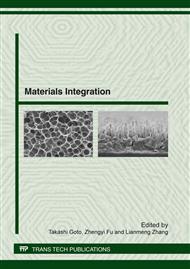p.211
p.215
p.220
p.224
p.230
p.235
p.240
p.247
p.253
Densification of ATO Nanoceramics by Spark Plasma Sintering
Abstract:
High Density Antimony-Doped Tin Oxide (ATO) Ceramic Targets Are the Crucial Materials for Preparation of High Quality Transparent Conductive ATO Thin Films in Sputtering Process. In the Present Work, ATO Nanopowders with Different Sb2O3 Doping Content (0~10 mol%) Were Used to Fabricate the ATO Nanoceramics by Spark Plasma Sintering (SPS) Technique, which Can Reduce the Densification Temperature and Restrain a Grain Growth. And the Effect of Sb2O3 Doping Content (0~10 mol%) on the Density and Microstructure Had Been Investigated. the Results Showed that with the Sb2o3 Doping Content Increase, the Relative Density of ATO Nanoceramics Is Increased and the Resistivity Is Decreased. When the Sb2O3 Doping Content Is 10 mol%, the Relative Density Is 97.2% and the Resistivity Is 7.9×10-2 Ω•cm.
Info:
Periodical:
Pages:
230-234
Citation:
Online since:
March 2012
Authors:
Price:
Сopyright:
© 2012 Trans Tech Publications Ltd. All Rights Reserved
Share:
Citation:


